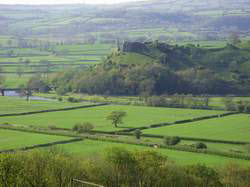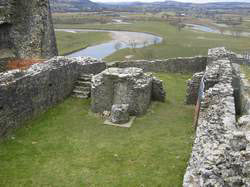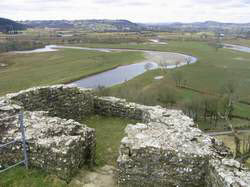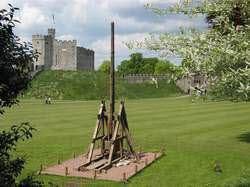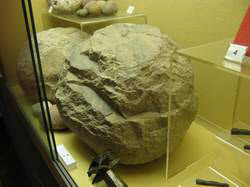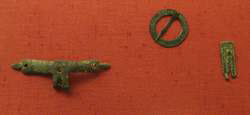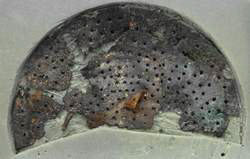C Caple and C Phillpotts, Chapter 2 in C Caple, Excavations at Dryslwyn Castle 1980-
The original design of Dryslwyn castle was very similar to that of Dinefwr castle, comprising a round tower with flared base and a ward that followed the contours of the hillside. A great hall was built within the ward, and a smaller building nearby that may have been the kitchen. In addition a small structure was fitted in between the hall and the curtain wall. In the excellent CADW guidebook to Dinefwr and Dryslwyn castles Rees and Caple have suggested this may have been a prison.
S E Rees and C Caple, Dinefwr Castle and Dryslwyn Castle, CADW, 2007.
We will move on to the reign of Edward I, who came to the throne in 1272. Edward was determined to crush the resistance of those parts of Wales that remained relatively independent, especially as Llewelyn ap Gruffudd, the grandson of Llewelyn the Great, had managed to establish a position of authority. Under Henry III Llewelyn's status had been recognised with the award of the title Prince of Wales. An English army was assembled at Carmarthen in 1277, and much of south west Wales, including Dinefwr, soon submitted to it. Dinefwr, at that time ruled by Rhys Wyndod, was confiscated by the king and placed in the custody of the Justiciar of west Wales, Bogo de Knovill.
At Dryslwyn the ruler Rhys ap Maredudd was allowed to keep his castle as he had shown a more conciliatory attitude to the English. He felt aggrieved, however, that he was not also given Dinefwr, and after becoming involved in a series of disputes with the new Justiciar Robert de Tibetot, he resorted to military action, attacking the castles at Carreg Cennen and Llandovery as well as Dinefwr in 1287. The English assembled an army of over 11,000 men to suppress the revolt in a campaign that culminated in a siege of Dryslwyn castle that lasted over three weeks.
A great deal is known about the 1287 siege of Dryslwyn from contemporary documentary evidence. In addition the archaeological investigations of Chis Caple and his colleagues have uncovered examples of the weapons, chain mail, and projectiles that were used. The documents tell us, for example, the names of the leaders of the English expedition, how the expedition was funded (in particular through Italian bankers based in London), where the troops came from (for example 2000 foot soldiers and 20 cavalry came from Gwynedd, 1280 foot soldiers from Herefordshire, and 26 crossbowmen from Bristol), the various categories of support staff (including woodcutters, carpenters, quarrymen, masons, smiths, and diggers), the wages paid to each group, and where food and other supplies came from.
For a full account of the siege go to Chapter 7 in C Caple, Excavations at Dryslwyn Castle 1980-
Methods of assault used by the English army included undermining the castle walls and the use of a trebuchet. A major incident occurred when a group of senior English knights entered the undermining cavity. The props gave way and the ground and wall above the mine collapsed. The knights and probably several diggers were crushed to death.
The trebuchet was constructed on site with timber felled in the local woods. It was built under the direction of Master Richard the Engineer from Chester. It was probably set up on the valley floor east of the castle, from where it would have been necessary to project missiles to an altitude of about 60 metres to reach the castle above. It would have been within range of arrows fired from the castle, and protective hurdles may have been used to protect its operators. It was capable of firing stones weighing 50 kilograms, but more often large batches of smaller stones would have been fired. After the siege at Dryslwyn the trebuchet was partially taken apart and transported to Newcastle Emlyn for use against the castle there.
Dryslwyn castle surrendered on 8 September 1287. Many of the supporters of Rhys ap Maredudd were killed or captured, but Rhys himself escaped. He remained free until he was betrayed by four of his own men in 1292. He was tried for treason in the presence of Edward I in York and then executed in a nasty fashion.
Dryslwyn castle from the south east
The great hall
The remains of what may have been a prison
A trebuchet in the grounds of Cardiff castle. The trebuchet used at Dryslwyn would have been a lot bigger.
Trebuchet balls found at Dryslwyn by Chris Caple and his team. The ball in front weighs 52 kilograms. Also shown are smaller projectile stones and a macehead.
These objects are on display at Carmarthenshire County Museum.
Some copper alloy objects found at Dryslwyn, including an annular brooch with the inscription
X IHESUS NAZARANUS
Fragments of a metal bowl from a long-
The objects found at Dryslwyn have been fully described and illustrated in C Caple,
Excavations at Dryslwyn Castle 1980-
